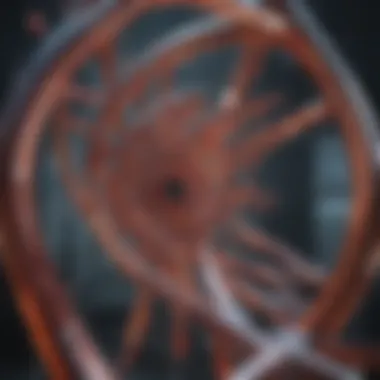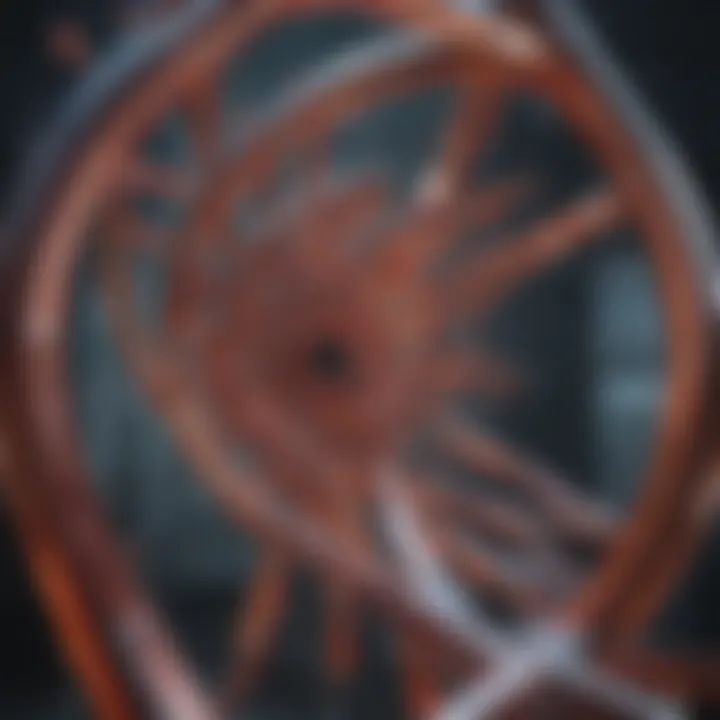Comprehensive Review of the DNA Strider Framework


Article Overview
Purpose of the Article
The purpose of this article is to provide a comprehensive examination of the DNA Strider framework, an essential tool for anyone involved in genetic research or bioinformatics. By delving into its intricacies, the article aims to illuminate not just how the framework operates, but also reveals its significance in contemporary scientific inquiry. The exploration further ties the technical capabilities of DNA Strider to real-world applications, enhancing the reader's understanding of its role in advancing the field.
Relevance to Multiple Disciplines
DNA Strider stands as a bridge across various scientific disciplines. From molecular biology to bioinformatics, the framework's versatility allows it to serve a broad audience including researchers, educators, and students alike. Particularly, it's pivotal in areas such as:
- Sequence analysis
- Genomic annotation
- Mutation detection
- Comparative genomics
The framework’s ability to adapt to numerous scenarios makes it an invaluable asset, fostering collaborative efforts across different branches of science.
Research Background
Historical Context
To fully appreciate the DNA Strider framework, one must take a step back and consider the landscape of genetic research prior to its inception. The field of molecular biology has witnessed monumental shifts toward more computational methods. As the human genome project brought vast amounts of data to the forefront, the need for sophisticated analytic tools became paramount. DNA Strider emerged as a response to this demand, providing researchers with a streamlined interface to tackle complex genetic information.
Key Concepts and Definitions
Understanding DNA Strider requires familiarity with some foundational concepts in genetics and bioinformatics. Here are several key terms that frame the discussion:
- Bioinformatics: The intersection of biology and computer science, focusing on the development of algorithms and software for collecting, storing, and analyzing biological data.
- Sequence Alignment: A method of arranging the sequences of DNA, RNA, or protein to identify regions of similarity that may indicate functional or evolutionary relationships.
- Genomic Annotation: The process of identifying the locations of genes and all of the coding regions in a genome and determining what those genes do.
As we explore the functionality and applications of DNA Strider, a clear connection to these concepts will highlight its role as a critical player in advancing genetic research.
Preamble to DNA Strider
DNA Strider is a specialized framework extensively utilized within the realms of genetic research and bioinformatics. Its importance cannot be overstated as it provides researchers and biologists with powerful tools to analyze and visualize DNA sequences. From its inception to its current applications, DNA Strider has evolved into an indispensable asset for professionals delving into the intricacies of genetic material. Understanding the tools available is crucial for both seasoned experts and newcomers navigating the complexities of molecular biology.
Historical Context
The roots of DNA Strider trace back to the early days of molecular biology when researchers were first discovering the structure and function of DNA. Since its establishment in the late 1980s, DNA Strider has undergone significant transformations. Originally designed as a response to the need for software that could handle and manipulate DNA sequences, it quickly gained traction in the academic community. With so many researchers relying on nucleotide sequencing data, the demand for a robust platform became apparent.
Developers, including those inspired by advancements in computing and graphics technology, crafted DNA Strider to provide an easily navigable interface for handling biological data. This software began as a simple sequence viewer and blossomed into a comprehensive analysis tool, incorporating various functionalities and an evolving user interface.
Now, DNA Strider stands as a beacon in genetic research, underpinning many significant discoveries and advancements in various fields such as medicine, agriculture, and evolutionary studies.
Relevance in Modern Genetics
In today’s fast-paced scientific environment, DNA Strider’s relevance cannot be emphasized enough. Modern genetics is a tapestry woven with complex strands of data, requiring sophisticated tools for comprehensive analysis. DNA Strider acts as a bridge, connecting massive datasets with user-friendly functionalities that empower researchers to visualize, annotate, and manipulate genetic information effectively.
The continuing advancements in genome sequencing technologies fuel the need for adaptable software solutions. DNA Strider hits the mark, allowing users to quickly graph DNA fragments, highlight significant sequences, and manipulate data seamlessly. Here are some specific reasons why it remains at the forefront of genetic analysis:
- User-Centric Design: Provides an interface that aids in efficient navigation and understanding of complex biological data.
- Flexible Functionality: Facilitates various analyses crucial for tasks such as molecular cloning and gene annotation.
- Community Support: Benefits from a growing base of users who contribute to its ongoing enhancement and documentation, thus ensuring that it remains relevant.
With these features, DNA Strider not only bridges the gap between raw genetic data and actionable insights but also fosters a deeper understanding of the underlying biological processes. Its contributions to current genetic studies and its capabilities to adapt to future needs make it a relevant choice for anyone involved in genetic research.
Technical Features of DNA Strider
Understanding the technical features of the DNA Strider framework is crucial for anyone involved in genetics or bioinformatics. This section focuses not only on the core functionalities but also on user interaction and data visualization. Each of these elements contributes to making DNA Strider a coveted tool among researchers. The significance lies in how these features enhance research efficiency and the accuracy of genetic analysis.
Overview of Core Functionalities
DNA Strider offers a robust set of core functionalities that addresses various needs in genetic research. At its foundation, the tool supports sequence analysis, allowing users to perform operations such as sequence alignment, primer design, and restriction enzyme mapping. This ability to manage and manipulate genetic sequences effectively can prove invaluable in achieving precise results.
Among its standout features is the capability for molecular cloning. Researchers can import DNA sequences from various formats and seamlessly integrate them into cloning projects. The software also allows for the design of vectors and customization of sequences, which further tailors the tool to specific research requirements.
Additionally, DNA Strider supports the analysis of contig assemblies and the integration of databases, making the process of genetic research much more streamlined.
User Interface and Interaction


The user interface (UI) of DNA Strider is designed with accessibility in mind. Users, whether seasoned researchers or newcomers, can navigate the interface without stumbling over technical jargon or overly complex layouts. Clean lines and intuitive navigation ease the overall experience, allowing for a focus on task completion.
Users benefit from well-organized menus that categorize functionalities logically. For instance, essential operations such as sequencing and cloning are easily reachable within the UI. Moreover, real-time feedback during tasks helps users correct any mistakes promptly, which can save time and frustration in delicate experiments.
Through community forums and online resources, many users have shared their insights on optimizing their interaction with DNA Strider's UI, creating a collaborative atmosphere for both learning and improving the user experience.
Data Visualization Capabilities
Data visualization is an essential part of genetic research, and DNA Strider does not disappoint in this regard. The software provides various visualization tools, enabling users to see their data represented in multiple formats, such as graphs, charts, and directional maps. This feature is particularly helpful for understanding complex relationships within genetic data and communicating findings effectively.
Another significant aspect of data visualization in DNA Strider is the export functionality. Visual representations created within the platform can be easily exported for use in presentations or publications. This capability is crucial in an academic or research setting where clarity of communication is paramount.
Users can customize these visual outputs according to their preferences, ensuring that the data is not only informative but also aesthetically pleasing. Thus, the combination of functionality and visual appeal makes the information conveyed more digestible for diverse audiences.
"In genetic research, the ability to visualize data effectively is almost as important as the data itself. It fosters comprehension and drives discussion."
"In genetic research, the ability to visualize data effectively is almost as important as the data itself. It fosters comprehension and drives discussion."
Through these technical features, DNA Strider solidifies its position as a leader in bioinformatics tools, allowing researchers to navigate the complexities of genetic analysis with confidence and precision.
Applications of DNA Strider in Research
DNA Strider plays a crucial role in the field of genetic research and bioinformatics. It serves as a versatile tool that facilitates various applications, each contributing importantly to the advancement of molecular biology. From cloning techniques to gene annotation, DNA Strider provides a comprehensive platform that streamlines scientific processes and enhances research outcomes. In this section, we will explore three key applications where DNA Strider proves invaluable: molecular cloning techniques, gene annotation processes, and studying genetic variation.
Molecular Cloning Techniques
Molecular cloning is a foundational method in genetic engineering that allows researchers to create copies of specific DNA sequences. DNA Strider enhances this process by offering a user-friendly interface alongside powerful features that aid in the exploration and manipulation of genetic material. The ability to design and visualize plasmids with precision offers a tactical advantage to scientists.
Benefits of using DNA Strider in molecular cloning include:
- Visualization of Plasmids: Users can easily create maps for plasmids, making it simpler to identify restriction sites and design strategies for cloning.
- Sequence Analysis: The software allows for efficient sequence alignments which are crucial when comparing different genetic variants.
- Simulation of Reactions: It also provides tools for simulating potential cloning reactions, helping researchers anticipate outcomes before actual experimentation.
This capability saves time and resources in experimental setups, essentially acting as a preparatory tool that avoids common pitfalls in cloning workflows.
Gene Annotation Processes
Gene annotation, the process of identifying and marking genes in a sequence, is fundamental in understanding gene functions and interactions. DNA Strider’s tools for gene annotation streamline this intricate process.
Key features for gene annotation in DNA Strider include:
- Automated Annotation Tools: Users can input raw sequence data and quickly receive preliminary annotations, allowing for rapid initial assessments.
- Integration with Databases: The platform supports integration with public databases, making it easy to enrich annotations with previously identified function data.
- User-defined Parameters: Researchers can define specific parameters for annotations, tailoring the analysis to their unique experimental needs.
Such features foster collaboration among researchers and accelerate the pace of discovery. By providing a clear framework for annotation, DNA Strider ensures that crucial genetic insights are gathered with efficiency and accuracy.
Studying Genetic Variation
Understanding genetic variation is essential in areas like population genetics, evolutionary biology, and medical research. DNA Strider facilitates the exploration of these variations by allowing scientists to analyze genetic sequences for polymorphisms and other variations.
Some important aspects of studying genetic variations with DNA Strider include:
- Comparative Analysis: The software allows researchers to compare different genomes, identifying variations that may lead to phenotypic changes or diseases.
- Visualization of Haplotypes: DNA Strider provides tools for visualizing haplotypes, making genetic structures easier to interpret.
- Statistical Tools: It offers various statistical tools for evaluating the significance of genetic variations, helping researchers draw meaningful conclusions from their data.
Through these capabilities, DNA Strider aids researchers not just in cataloging variations but also in understanding their implications, paving the way for significant advancements in genetic research.
"DNA Strider’s applications in research not only simplify complex tasks but also enhance the overall understanding of genetic frameworks, proving indispensable in modern science."
"DNA Strider’s applications in research not only simplify complex tasks but also enhance the overall understanding of genetic frameworks, proving indispensable in modern science."
In summary, the applications of DNA Strider in research are vast and impactful. This software is more than just a tool; it is a collaborator that supports scientists in unraveling the complexities of genetic material, ultimately leading to profound advancements in the field.
Comparative Analysis with Other Tools
The comparative analysis of DNA Strider with other bioinformatics tools is crucial for understanding its unique position in the market and the benefits it offers to genetic researchers. Given the plethora of software available today, conducting a thorough evaluation helps users make informed choices based on their specific needs and project requirements. This section dives deep into two main areas: the assessment of efficacy and feature comparisons, which serve as keystones in highlighting DNA Strider's value.


Assessment of Efficacy
Evaluating the effectiveness of DNA Strider against its competitors reveals its strengths and weaknesses. Numerous studies in recent years have solidified its reputation as a reliable tool for DNA sequence analysis. Consider some essential benchmarks when assessing efficacy:
- Accuracy of Results: DNA Strider consistently delivers precise outcomes, which is paramount in genetic research. Users have noted its sensitivity in detecting subtle genomic alterations compared to other similar tools.
- Speed of Processing: In an era where time is of the essence, the quick turnaround for data analysis in DNA Strider is noteworthy. Users can expect reduced waiting times when processing large datasets.
- Scalability: As projects grow in complexity, needing more computational power, DNA Strider performs well under various loads, showing flexibility in adapting to diverse user demands.
This efficacy assessment can significantly influence user decisions, especially for researchers who prioritize reliable results within tight timeframes. By focusing on these benchmarks, DNA Strider distinguishes itself as a worthy contender in any laboratory toolkit.
Feature Comparisons
When it comes to functionality, each software solution offers its own unique features designed to tackle the challenges in genetic research. Below are some notable comparisons between DNA Strider and other popular tools:
- User Interface: DNA Strider boasts an intuitive user interface that facilitates easy navigation, a feature not always matched by its competitors. A seamless experience can make a world of difference for newcomers in bioinformatics.
- Data Visualization: Unlike several rival tools, DNA Strider offers robust options for visualizing genetic data. Its ability to represent complex datasets clearly allows researchers to derive actionable insights quickly.
- Support for Multiple File Formats: DNA Strider pairs well with various file formats, including FASTA and GenBank. This ability ensures researchers can easily integrate the tool into their existing workflows without compatibility headaches.
- Community Contributions: One distinctive element of DNA Strider is its active user community. Engaged users contribute plugins and extensions which enhance the software's capabilities beyond the standard features.
In summary, a well-rounded comparative analysis helps illuminate how DNA Strider stacks up against other tools, guiding users toward making the best choice for their research needs.
"When comparing tools, knowing what works best for your specific needs is key to making significant advancements in bioinformatics."
"When comparing tools, knowing what works best for your specific needs is key to making significant advancements in bioinformatics."
This examination of DNA Strider emphasizes the features that give it an edge in certain circumstances, all while acknowledging the merits of its competitors. Understanding where DNA Strider shines can lead to more successful outcomes in genetic studies.
User Feedback and Community Support
User feedback and community support are essential cogs in the machinery of any robust software framework, including DNA Strider. The input from users not only influences future development but also enhances user satisfaction, creating a cycle of ongoing improvement. In the realm of genetic research, where tools can often be quite complex, an active community can make a world of difference. It’s akin to having a group of hiking buddies ready to give directions or share tips on taking the best trail when one feels lost in the woods.
User Experiences
The experiences of those who actively utilize DNA Strider shed light on its real-world applications. A swath of testimonials exists from researchers, educators, and students alike, each recounting their unique journey with the framework. Users frequently cite the ease of navigation within the interface, which allows them to focus on their genetic analyses without getting bogged down in technical hurdles. Their insights often reveal that intuitive features—like drag-and-drop functionality for datasets—lead to a quicker understanding of complex data.
For instance, a graduate student working on a molecular cloning project noted that the step-by-step guides provided by seasoned users in the community helped them grasp essential concepts much faster than they could through traditional learning methods. Others appreciate how community forums on platforms like Reddit offer timely answers to specific queries, reducing the time wasted searching for solutions independently.
In contrast, there are also mentions of areas where users feel improvements could be made. Some have noted the occasional hiccup with data visualization tools not aligning as anticipated. This illustrates the dynamic nature of user feedback; it serves not only to praise existing successes but also to spotlight areas needing attention. The honest sharing of experiences contributes positively to the overall development of DNA Strider as it evolves.
Support and Documentation
Robust support and comprehensive documentation are absolute prerequisites for any tool in the biomedical field. With DNA Strider, this is no different. Good documentation serves as the backbone, equipping users with the knowledge they need to maximize the tool's capabilities. The well-structured guides offered provide clarity on how to navigate through various features, ranging from sequence analysis to advanced data integration techniques.
Still, having a supportive community is just as vital as the documentation itself. As users delve into complex research, they often find themselves running into unique challenges that traditional documentation might not cover. Here is where forums and online communities become invaluable. Users collaborate and share strategies, extending the documentation’s reach far beyond what a single manual can offer. On platforms like Facebook, dedicated groups focus on sharing tips and tricks to enhance the user experience further.
To sum it up, the interplay between comprehensive documentation and community support fosters a collaborative environment, empowering users to become better equipped researchers. As individuals share their journeys and solutions, they build a collective knowledge base that ultimately benefits everyone involved in the DNA Strider ecosystem.
Recent Developments in DNA Strider
In the fast-paced world of biomolecular science, keeping up with the latest advancements is crucial. The DNA Strider framework has witnessed several notable developments that significantly enhance its functionality, offering researchers and educators a robust tool for genetic analysis.
Updates and New Features
Recent updates to DNA Strider have introduced a range of features aimed at improving user experience and expanding its capabilities. One of the most critical new additions is the enhanced data analysis module, which now includes tools for handling large genomic datasets. This improvement allows for quicker processing times and more accurate results, making it easier for users to conduct large-scale studies without the frustration of waiting on slow computations.
Moreover, the integration of cloud-based storage solutions simplifies data management. Users can store their projects securely online, accessing them from various devices. This means researchers can collaborate more efficiently without being tied to a single workstation. Additionally, the latest version has introduced a more intuitive user interface, making navigation a breeze for both new users and seasoned experts. The streamlined layout reduces the learning curve, enabling quicker onboarding for students and those new to bioinformatics.
Furthermore, real-time data visualization capabilities have been enhanced, allowing users to make sense of complex genetic information at a glance. With dynamic graphs and models that update automatically with input adjustments, researchers can explore their findings more interactively. This hands-on approach not only aids in comprehension but also enhances the overall research experience.
Integration with Other Platforms
The integration of DNA Strider with other platforms marks a significant step forward for collaborative scientific efforts. By facilitating seamless compatibility with major bioinformatics databases and software like GenBank and BLAST, DNA Strider allows users to import and export data with minimal friction.
This multi-platform integration strategy means that whether a researcher is examining genetic sequences or conducting comparative analyses, they can do so without being bogged down by the tedium of data transfer. Just a few clicks are often all that’s needed to synchronize data across various tools.
Another notable advancement is its API capabilities. These allow developers to create custom applications or plugins that extend DNA Strider's core functionality. This opens countless possibilities for specialized tools tailored to specific research areas or teaching strategies.
Integrating DNA Strider with other platforms not only enhances functionality but also fosters a collaborative environment, opening new avenues for innovation and research.


Integrating DNA Strider with other platforms not only enhances functionality but also fosters a collaborative environment, opening new avenues for innovation and research.
Whether researchers are delving into the mysteries of the genetic code or teaching the next generation of scientists, these enhancements serve to empower users in their biomolecular pursuits.
Impact on Biomolecular Research
The DNA Strider framework has significantly altered the landscape of biomolecular research. Its contributions extend across various facets of genetic exploration and bioinformatics, allowing researchers to navigate complex datasets with greater efficiency and reliability. Falling in line with a pivotal role, DNA Strider offers a mix of advanced analytical capabilities that cater to both seasoned scientists and students delving into genetics.
Influence on Genetic Discoveries
One cannot overlook how DNA Strider has influenced genetic discoveries. By providing robust analytical tools, it enhances the ability to identify and characterize genetic variants quickly. Researchers often rely on software tools that assist in managing vast amounts of genetic data, and DNA Strider stands out in this domain. With features such as sequence alignment and primer design, it facilitates the acceleration of research timelines.
The platform empowers geneticists to uncover rare mutations or significant polymorphisms. For example, during whole-genome sequencing projects, the data generated can be overwhelming. DNA Strider simplifies this by enabling users to focus on specific regions of interest without losing sight of the bigger picture. In doing so, it not only supports initial discovery but also aids in confirming findings through its diverse data representation formats. It is this duality that allows professionals to dive deeper into the complexities of genetics, leading to novel findings that can transform therapeutic approaches and understanding of fundamental biological processes.
"The DNA Strider framework reshapes our understanding of genetics, shedding light on opportunities previously deemed elusive."
"The DNA Strider framework reshapes our understanding of genetics, shedding light on opportunities previously deemed elusive."
Role in Educational Settings
In educational setup, the potency of DNA Strider is equally compelling. As students learn about the intricacies of molecular biology, platforms like DNA Strider serve as educational tools that enhance the learning experience. Instructors can incorporate real-world applications of genetic analysis into the curriculum, providing students with hands-on experience.
Courses that cover topics such as molecular cloning or genome annotation benefit immensely from having a functional tool like DNA Strider. Students can conduct experiments, analyze genetic data, and visualize results in a controlled yet explorative environment.
The interactive nature of the software allows budding geneticists to make errors, learn, and refine their methodology, all while being engaged in the subject matter. This can help demystify concepts that initially seem abstract, fostering a meaningful connection between theoretical knowledge and practical application. By cultivating a generation that is well-versed in bioinformatics, DNA Strider effectively contributes to the overall growth of the scientific community, ensuring that the future of biomolecular research is in capable hands.
In summary, DNA Strider’s impact on biomolecular research cannot be underestimated. It bridges gaps in genetic discoveries and serves as a crucial tool in educational settings. The way forward involves embracing and optimizing tools like DNA Strider to harness the full potential of genomics and elevate the standard of scientific inquiry across the board.
Future Prospects of DNA Strider
The future prospects of DNA Strider carry significant weight in the world of genetic research. As this framework continues to evolve, it holds new potential to address challenges in data analysis, accessibility, and interconnectivity with other bioinformatics tools. The relevance of these advancements is considerable for researchers, educators, and students alike, as they open doors to novel discoveries and streamlined workflows in biomolecular sciences.
Emerging Trends to Watch
One of the more exciting developments within the DNA Strider ecosystem is its ability to keep pace with emerging trends in the field of genomics. It appears likely that we will see a stronger alignment with big data analytics and machine learning techniques. The future might hold features that not only analyze but predict genetic variations based on existing data patterns. These transformations can enhance the accuracy of molecular cloning tasks, making the research process more insightful and efficient.
Additionally, the integration of user-friendly interfaces and enhanced real-time collaboration tools is also on the horizon. This shift can facilitate better communication among research teams, allowing for collective problem-solving and resource sharing in real-time. Whether it’s through webinars, forums, or social sharing on platforms like Reddit, DNA Strider could become more than just a tool, turning into a comprehensive community resource.
Potential for Innovations
Innovation is the lifeblood of scientific progress and DNA Strider is positioned to spearhead new methodologies in genetic analysis. The likelihood of incorporating innovative algorithms that could automate complex tasks is promising. For instance, imagine a scenario where gene annotation processes are fully automated, reducing hours of manual work into mere minutes. Such advancements would not only save time but also minimize human errors.
Moreover, there’s a growing interest in cross-platform compatibility. The future might see DNA Strider seamlessly integrating with other platforms such as Galaxy or Benchling, creating a more robust ecosystem for researchers. This interconnectedness can streamline input, processing, and output stages in genetic research, making comprehensive data management a reality.
Furthermore, the potential for utilizing cloud-based solutions is enticing. Storing large volumes of genetic data in the cloud could ease accessibility and security concerns, allowing users to collaborate across the globe without the typical barriers.
These trends and innovations collectively indicate that the DNA Strider framework is not simply resting on its laurels; it's gearing up for a future rich in possibilities. As research methodologies advance, so too must the tools we utilize in those methodologies. The framework's adaptability will be a cornerstone for ongoing education and discovery in this ever-evolving field.
Finale
The conclusion of this article on DNA Strider serves as a critical element in encapsulating the vast information discussed previously. It is not just a simple wrap-up; rather, it synthesizes the critical insights gained throughout the article. Engaging with topics like the technical features, applications, recent developments, and future prospects, provides a comprehensive understanding of the DNA Strider framework’s significance in genetic research.
Summary of Key Insights
The key points extracted from this analysis reveal DNA Strider as a versatile tool that is pivotal within the realms of genetic research and bioinformatics. Here are some standout insights:
- Historical Context and Evolution: Understanding its origins helps appreciate its advancements and adaptation to contemporary genetic needs.
- Technical Features: Its user-friendly interface, alongside robust data visualization capabilities, enhances its efficacy in molecular tasks.
- Applications in Research: From molecular cloning to studying genetic variations, DNA Strider offers a broad spectrum of utilities.
- Community Support: User experiences and ongoing documentation strengthen the collective knowledge surrounding the tool.
- Future Prospects: Continual updates and integrative capabilities with other platforms signal a promising trajectory for DNA Strider in future biomolecular endeavors.
Final Thoughts on DNA Strider's Role
In the quickly morphing landscape of genetic studies, DNA Strider stands as a beacon. Its capacity to support researchers and educators alike cannot be underrated. The following considerations help emphasize its importance:
- Facilitating Discovery: The software acts as a catalyst for genetic discoveries, enabling researchers to dig deeper into the genomic mysteries.
- Educational Integration: For learners and educators, DNA Strider provides a practical platform to grasp complex genetic concepts viably.
- Innovation Potential: As advancements in genetics unfold, the adaptability of DNA Strider ensures it remains at the forefront, poised for continual innovation.
"The future of genetic exploration is interwoven with tools like DNA Strider, which not only enhance research but also enrich educational practices."
"The future of genetic exploration is interwoven with tools like DNA Strider, which not only enhance research but also enrich educational practices."
In summary, the DNA Strider framework is not just a tool but a crucial ally in the ongoing quest to unlock the secrets of life itself. Its impact will echo in both practical applications and future innovations, marking it as an essential resource in the field of biomolecular research.



